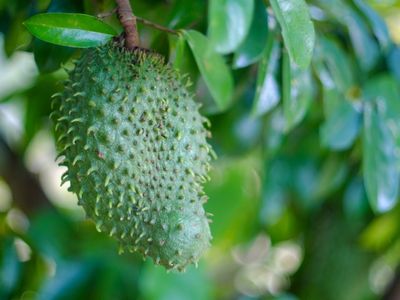What is Soursop?
The fruit of the soursop tree has a spiny outer skin with a soft, heavily seed-laden pulped interior. Each of these cauliflorous fruit may attain over a foot (30 cm.) in length and, when ripe, the soft pulp is used in ice creams and sherbets. In fact, this small evergreen tree produces the largest fruit in the Annonaceae family. Reportedly, the fruit may weigh up to 15 pounds (7 k.) (although the Guinness Book of World Records lists the largest as 8.14 pounds (4 k.)), and is often a lopsided heart shape. The white segments of the soursop fruit are primarily seedless, although a few seeds are present. The seeds and bark are toxic and contain poisonous alkaloids such as anonaine, muricine, and hydrocyanic acid. Soursop is known by a plethora of different names depending on its country of cultivation. The name, soursop is derived from the Dutch zuurzak which means “sour sack.”
How to Grow Soursop Trees
The soursop tree can reach height of 30 feet (9 m.) and is soil tolerant, although it flourishes in well drained, sandy soil with a pH of 5-6.5. A tropical specimen, this low branching and bushy tree does not tolerate cold or strong sustained winds. It will, however, grow at sea level and up to elevations of 3,000 feet (914 m.) in tropical climes. A rapid grower, soursop trees produce their first crop three to five years from seeding. Seeds stay viable for up to six months but better success is met by planting within 30 days of harvest and seeds will germinate within 15-30 days. Propagation is usually through seeds; however, fiberless varieties can be grafted. Seeds should be washed before planting.
Soursop Tree Care
Soursop tree care involves copious mulching, which benefits the shallow root system. Overly high temps from 80-90 F. (27-32 C.) and low relative humidity cause pollination issues while slightly lower temps and 80 percent relative humidity improve pollination. Soursop trees should be irrigated regularly to prevent stress, which will cause leaf drop. Fertilize every quarter of the year with a 10-10-10 NPK at ½ pound (0.22 kg.) per year for the first year, 1 pound (.45 kg.) the second, and 3 pounds (1.4 kg.) for every year thereafter. Very little pruning is required once the initial shaping is attained. You should only need to prune out dead or diseased limbs, which should be done once harvest is over. Topping the trees at 6 feet (2 m.) will facilitate harvesting.
Harvesting Soursop Fruit
When harvesting soursop, the fruit will change from dark green to a lighter yellowish green tone. The spines of the fruit will soften and the fruit will swell. Soursop fruit will take between four to five days to ripen once picked. Trees will produce at least two dozen fruit per year.
Soursop Fruit Benefits
Besides its pleasant flavor, soursop fruit benefits include 71 kcal of energy, 247 grams of protein, and calcium, iron, magnesium, potassium and phosphorus — not to mention it’s a source of vitamins C and A. Soursop can be eaten fresh or used in ice cream, mousse, jellies, soufflés, sorbet, cakes and candy. Filipinos use the young fruit as a vegetable while in the Caribbean, the pulp is strained and the milk mixed with sugar to drink or mix with wine or brandy.
